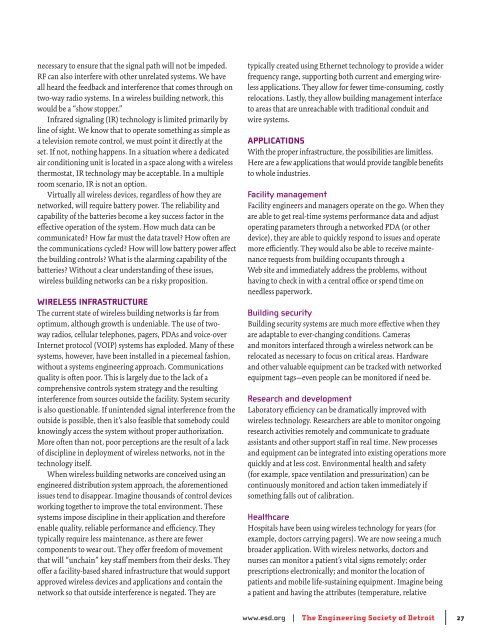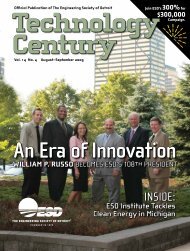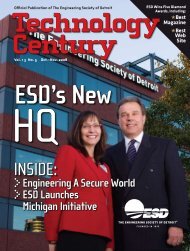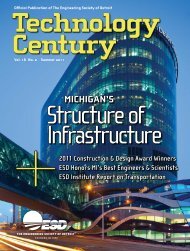Download - ESD
Download - ESD
Download - ESD
- No tags were found...
Create successful ePaper yourself
Turn your PDF publications into a flip-book with our unique Google optimized e-Paper software.
necessary to ensure that the signal path will not be impeded.<br />
RF can also interfere with other unrelated systems. We have<br />
all heard the feedback and interference that comes through on<br />
two-way radio systems. In a wireless building network, this<br />
would be a “show stopper.”<br />
Infrared signaling (IR) technology is limited primarily by<br />
line of sight. We know that to operate something as simple as<br />
a television remote control, we must point it directly at the<br />
set. If not, nothing happens. In a situation where a dedicated<br />
air conditioning unit is located in a space along with a wireless<br />
thermostat, IR technology may be acceptable. In a multiple<br />
room scenario, IR is not an option.<br />
Virtually all wireless devices, regardless of how they are<br />
networked, will require battery power. The reliability and<br />
capability of the batteries become a key success factor in the<br />
effective operation of the system. How much data can be<br />
communicated How far must the data travel How often are<br />
the communications cycled How will low battery power affect<br />
the building controls What is the alarming capability of the<br />
batteries Without a clear understanding of these issues,<br />
wireless building networks can be a risky proposition.<br />
WIRELESS INFRASTRUCTURE<br />
The current state of wireless building networks is far from<br />
optimum, although growth is undeniable. The use of twoway<br />
radios, cellular telephones, pagers, PDAs and voice-over<br />
Internet protocol (VOIP) systems has exploded. Many of these<br />
systems, however, have been installed in a piecemeal fashion,<br />
without a systems engineering approach. Communications<br />
quality is often poor. This is largely due to the lack of a<br />
comprehensive controls system strategy and the resulting<br />
interference from sources outside the facility. System security<br />
is also questionable. If unintended signal interference from the<br />
outside is possible, then it’s also feasible that somebody could<br />
knowingly access the system without proper authorization.<br />
More often than not, poor perceptions are the result of a lack<br />
of discipline in deployment of wireless networks, not in the<br />
technology itself.<br />
When wireless building networks are conceived using an<br />
engineered distribution system approach, the aforementioned<br />
issues tend to disappear. Imagine thousands of control devices<br />
working together to improve the total environment. These<br />
systems impose discipline in their application and therefore<br />
enable quality, reliable performance and efficiency. They<br />
typically require less maintenance, as there are fewer<br />
components to wear out. They offer freedom of movement<br />
that will “unchain” key staff members from their desks. They<br />
offer a facility-based shared infrastructure that would support<br />
approved wireless devices and applications and contain the<br />
network so that outside interference is negated. They are<br />
typically created using Ethernet technology to provide a wider<br />
frequency range, supporting both current and emerging wireless<br />
applications. They allow for fewer time-consuming, costly<br />
relocations. Lastly, they allow building management interface<br />
to areas that are unreachable with traditional conduit and<br />
wire systems.<br />
APPLICATIONS<br />
With the proper infrastructure, the possibilities are limitless.<br />
Here are a few applications that would provide tangible benefits<br />
to whole industries.<br />
Facility management<br />
Facility engineers and managers operate on the go. When they<br />
are able to get real-time systems performance data and adjust<br />
operating parameters through a networked PDA (or other<br />
device), they are able to quickly respond to issues and operate<br />
more efficiently. They would also be able to receive maintenance<br />
requests from building occupants through a<br />
Web site and immediately address the problems, without<br />
having to check in with a central office or spend time on<br />
needless paperwork.<br />
Building security<br />
Building security systems are much more effective when they<br />
are adaptable to ever-changing conditions. Cameras<br />
and monitors interfaced through a wireless network can be<br />
relocated as necessary to focus on critical areas. Hardware<br />
and other valuable equipment can be tracked with networked<br />
equipment tags—even people can be monitored if need be.<br />
Research and development<br />
Laboratory efficiency can be dramatically improved with<br />
wireless technology. Researchers are able to monitor ongoing<br />
research activities remotely and communicate to graduate<br />
assistants and other support staff in real time. New processes<br />
and equipment can be integrated into existing operations more<br />
quickly and at less cost. Environmental health and safety<br />
(for example, space ventilation and pressurization) can be<br />
continuously monitored and action taken immediately if<br />
something falls out of calibration.<br />
Healthcare<br />
Hospitals have been using wireless technology for years (for<br />
example, doctors carrying pagers). We are now seeing a much<br />
broader application. With wireless networks, doctors and<br />
nurses can monitor a patient’s vital signs remotely; order<br />
prescriptions electronically; and monitor the location of<br />
patients and mobile life-sustaining equipment. Imagine being<br />
a patient and having the attributes (temperature, relative<br />
www.esd.org | The Engineering Society of Detroit | 27
















